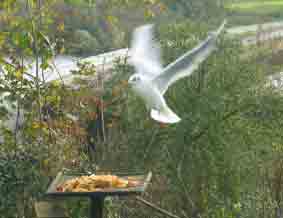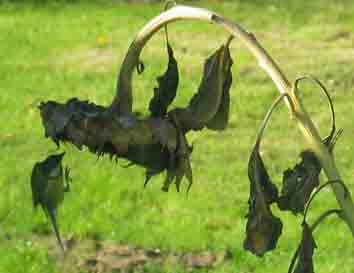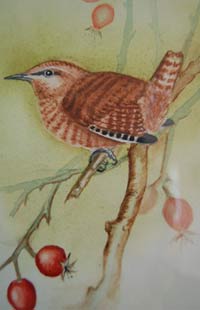A Homemade Bird Food from Suet and Scraps from your Table
It's great to feed the birds!
Here's an easy homemade bird food recipe which is suitable for children to make with some supervision. It uses recycled kitchen waste for most of the ingredients.

Picture above: Seagulls will eat almost anything. This black-headed gull is about to attack last night's pasta bake.
Bird food is easy to make if you use up some left-overs from your green kitchen and add a few choice elements to keep the birds well fed and happy.
Feeding the birds is a good way of upping your green living, especially if you are using locally sourced, organic foods and scraps for the most part. In many western counties a good deal of food is routinely wasted - as much as 30% in Britain, in recent years. In 2007 around 19% of landfill coming from households was found to be made up of food waste. As much as 3% of Britain's climate change gases are thought to come from wasted food, according to a recent WWF report.
Commercial wild bird food can be expensive. Using some of your nutritious, organic food scraps can help make the bought bird feed go further.
You can collect your ingredients gradually, over a day or two. Just keep things secure in your fridge until you are ready, making sure that no-one mistakes them for family food of course! Collect suet and fat from your roasting pan or from frying or grilling meat. Collect bread crumbs, old crackers, left over cooked pasta or rice.
Don't keep anything which is rancid or at all mouldy.
An easy bird cake recipe
Here is a recipe I was given recently. It's a bit similar to one we used when I was a child. It certainly keeps the backyard and garden birds coming back for more.
This recipe is suitable for a child to make.
Adult supervision should of course be given for the heating of the ingredients.
A selection of ingredients:
Select half a cup of lard, suet or other hard fat and a combination of any of these left-over ingredients:-
breadcrumbs, cookies, stale cake, sunflower seeds (hulled), unsalted crushed nuts such as peanuts, grated cheese, bacon rind, apple, pear, and dried fruit such as raisins
You also need an empty yogurt pot, string and a stick or twig wider than the pot. This is to contain your homemade bird food.
Method
- Chop up the ingredients and mix them together. Nuts should be chopped finely as small birds such as tits can choke on large pieces of nut.
- Melt the fat in a pan just enough so that the ingredients can be mixed in. Adult supervision of children is strongly advisable as fat can get very hot. Leave the fat to cool.
- Take the pot and make a small hole in the bottom.
- Thread the string up through the pot.
- Tie the twig onto the string at the open (top) end of the pot. This will be the perch.
- When the fat has cooled to a lukewarm temperature, mix it into the other ingredients.
- Carefully spoon the mixture into the pot around the string.
- Leave in a cool place until completely cold and set hard.
- Slowly turn the pot upsidedown so the twig is at the bottom, and pull the pot off the set mixture.
- Use the free end of the string to tie to the branch of a tree. Alternatively you can press the cooled mixture into cracks in tree bark - treecreepers and wrens love this!
You could also use that old trick of a half coconut to put the homemade bird food into.
Another method is to pour your bird cake mixture into muffin tins. Add a strong cotton string to each cake before it cools to provide a hanger.
One of the best things about doing it properly is that you get to watch the tits showing off their acrobatic skills ( - see the picture below of a hovering great tit getting at sunflower seeds).
If you are short of time you can just add the cooled mixture direct to a bird feeder, of course.
Homemade bird food:
Safety Advice
Make sure you use peanuts which have been grown for birds and never leave them whole - birds can choke on them.
Some less-than-scrupulous merchants may use poor quality nuts. There is a danger that they may contain aflatoxins which are poisonous to birds and humans. So make sure you always buy quality nuts. In the UK you can buy these on-line from Garden Bird See below for an organic supplier.
Just as for human health it is best to avoid too much salt, sugar and saturated fat, the same goes for wild birds. It is probably better to put left over Cheerios and Co-co Pops into the Bokashi recycler rather than give them to the birds.
A healthy homemade bird food, using quality ingredients is quite easy to make - and it's quite good fun, especially if you can get the kids to make it!
Click the picture below for more on growing plants for the birds - another source of great homemade bird food.

Picture: Growing sunflowers is easy and provides a feast for many garden birds. They look great in summer and then in autumn you can expect some acrobatics from the tits and finches.
Homemade bird food - other ingredients
Here are some other ingredients you might like to consider for your homemade bird food mixes. Rather than buy a ready made mix for birds, you can select the ingredients yourself and even create your own special mix to attract the birds you enjoy seeing.
There's a lot of cross-over in what birds will eat, depending upon the season and how hungry they are. But there are ways to encourage particular species, if you wish.
Corn millet is quite cheap and sparrows and lots of the finch family appreciate it.
Cracked corn is popular with many species - including squirrels! If you enjoy squirrels and want to encourage them you can buy special squirrel feeders. Many people will prefer to discourage them (they eat so much!) in which case a good squirrel proof bird feeder is a great asset.
Niger seeds (sometimes known as thistle seeds or spelt "nyger" seeds) can be added to the mix. Siskins, goldfinches and redpolls all enjoy niger seeds.
Safflower seeds have a reputation in north America for attracting the northern cardinal.
Sunflower seeds are immensely popular with many tits and finches and woodpeckers. "Black-oil" sunflower seeds are very good if you can find them. They have large kernels and the shells are thinner than the usual grey striped variety.
Homemade bird food:
Organic Bird Food
It is now possible to find sources of organic bird food, though you may need to search on-line to find them.
Vine House Farm in the UK grows a lot of the organic seeds they sell and they also support the Wildlife Trusts.
You can also use organic kitchen cereals for feeding your garden and backyard birds.
For more on organic cereals please see: Healthy cereals for a green kitchen
Homemade bird food tips
Here are some other things to think about.
Rancid fat is a turn off!
Remember that birds eat different things at different times of the year.
Suet and high fat foods are much more important in winter and during cold weather. On the other hand, fats easily become rancid in warm weather as well as being less desirable, so don't put out huge amounts of fatty food in summer and warm weather.
Clear away uneaten food regularly and wash down surfaces with a mild anti-bacterial agent. Vinegar and water with a little liquid detergent is simple and effective.
Homemade bird food:
A bit of grit
If you have room, put out a small pile of sand or fine grit. Many birds need suitable grit to help their digestion. In our neighbourhood the sparrows steal the grit left out for winter road gritting.
In an urban neighbourhood birds may find it hard to find suitable sources of unpolluted grit. Grit designed for pet cage birds is ideal. Common sand is also OK. Builders sand may contain too much salt.
Help them to help themselves!

Nature's larder is the best food source for our garden birds. We can help them by growing more organic bird feed in our gardens.
One of the very best ways to help your garden birds to feed themselves is to provide good habitat and natural food sources. You can do this in several ways. Perhaps the main way you can help is by growing good food plants, such as sunflowers (see link and picture above).
Picture: A wren perched on a wild rose bush. The best homemade bird food for wrens is probably a simple log pile. Piles of logs and cut shrubbery provide good homes for insects. This shy but vociferous little bird rarely visits the bird table.Go wild in the garden!
Another easy way is to leave quiet corners in your garden for a little wilderness and long grass. Many birds like grass seeds, for example - though of course, you may well be wary of them as potential weed sources!
Wrens and other birds benefit from old logs and shrub trimmings just left in piles. Many species of insect use these as habitat and that in turn helps the birds which feed on them. If you have space for even a small pile of old logs this is a great way to provide both food and shelter for birds.
Another way to help birds and small mammals is to use clods of earth to form natural banks between areas of your garden. You can make them from weeds and add some wildflower seeds to create a good resource for birds. I've got herbs growing on some of mine. They are easy to create and easy to maintain - provided that you don't want a very clipped and manicured garden!
*****
Homemade Bird Food - TOP
Organic Gardening
| Tweet |

| Tweet |

On other pages
Sponsored links
Footprints
- an occasional e-zine from Greenfootsteps
If you would like to receive the e-zine, please just sign up below.






New! Comments
Have your say about what you just read! Leave me a comment in the box below.